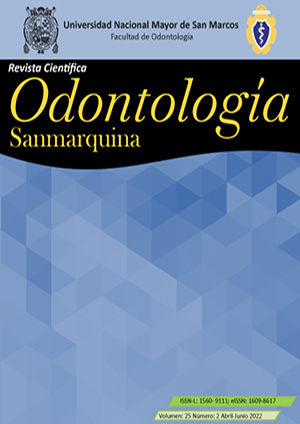Antibacterial effect of the ethanolic extract of Camellia sinensis and propolis, against strains of Streptococcus mutans
DOI:
https://doi.org/10.15381/os.v25i2.21298Keywords:
Antibacterial, Propolis, Camellia sinensis, Chlorhexidine, Streptococcus mutansAbstract
Objective. To determine the antibacterial effect of the ethanolic extract of green tea (Camellia sinensis) and propolis at a concentration of 10, 20 and 30% at 24 and 48 hours on Streptococcus mutans. Methods. Experimental, in vitro, comparative study, with a non-probabilistic sample of 150 paper discs, distributed in 30 Petri dishes previously prepared with blood agar and inoculated with strains of Streptococcus mutans, were placed 3 discs soaked in ethanolic extract at 10, 20 and 30%, 1 disk in 0.12% chlorhexidine (positive control) and 1 disk in distilled water, they were taken to the incubator and after 24 hours and 48 hours the measurements corresponding to the inhibition halos were made. The extracts were gotten by a modified maceration process, in a rotary stirring apparatus. Results. The highest inhibitory halo of the ethanolic extract of C. sinensis against Streptococcus mutans was in the concentration at 30% at 24 h and 48 h, while the highest inhibitory halo of the ethanolic extract of propolis, was in the concentration at 30% at 24 h; therefore, the natural extracts showed to be sensitive on the Duraffourd scale. Conclusions. It was evidenced that 30% propolis showed an antibacterial effect similar to chlorhexidine, considered gold standard, the time in which there was a greater antibacterial effect of the ethanolic extract of Camellia Sinensis and propolis against Streptococcus mutans, was at 24 hours, taking into account that the diameter of the inhibitory halos decreased, as the exposure time to the microorganism increased.
Downloads
Downloads
Published
Issue
Section
License
Copyright (c) 2022 Johana Liseth Acosta Asanza, Ana del Carmen Armas Vega

This work is licensed under a Creative Commons Attribution 4.0 International License.
AUTHORS RETAIN THEIR RIGHTS:
a. Authors retain their trade mark rights and patent, and also on any process or procedure described in the article.
b. Authors retain their right to share, copy, distribute, perform and publicly communicate their article (eg, to place their article in an institutional repository or publish it in a book), with an acknowledgment of its initial publication in the Odontología Sanmarquina.
c. Authors retain theirs right to make a subsequent publication of their work, to use the article or any part thereof (eg a compilation of his papers, lecture notes, thesis, or a book), always indicating the source of publication (the originator of the work, journal, volume, number and date).






